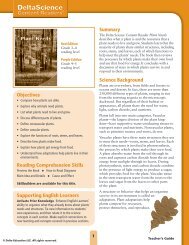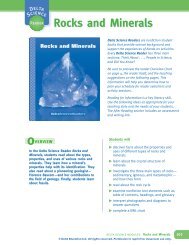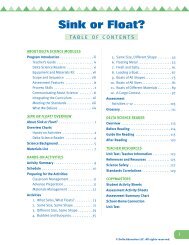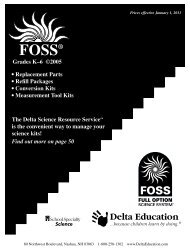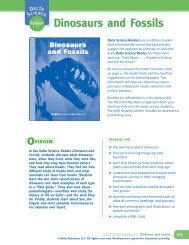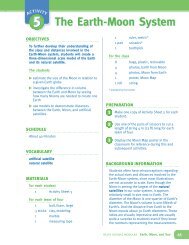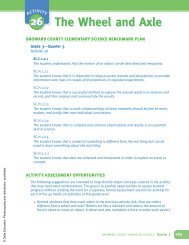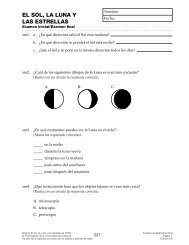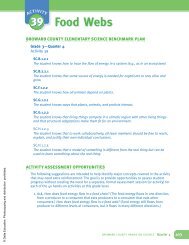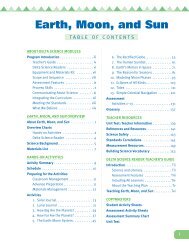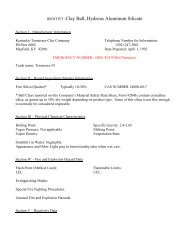Weather Forecasting -Teacher's Guide Table Of ... - Delta Education
Weather Forecasting -Teacher's Guide Table Of ... - Delta Education
Weather Forecasting -Teacher's Guide Table Of ... - Delta Education
You also want an ePaper? Increase the reach of your titles
YUMPU automatically turns print PDFs into web optimized ePapers that Google loves.
<strong>Weather</strong> <strong>Forecasting</strong>T ABLE OFCONTENTSABOUT DELTA SCIENCE MODULESProgram Introduction . . . . . . . . . . . . . . . . . . . iiiTeacher’s <strong>Guide</strong> . . . . . . . . . . . . . . . . . . . . . iv<strong>Delta</strong> Science Readers. . . . . . . . . . . . . . . . viEquipment and Materials Kit . . . . . . . . . . viiScope and Sequence. . . . . . . . . . . . . . . . viiiAssessment Features. . . . . . . . . . . . . . . . . ixProcess Skills . . . . . . . . . . . . . . . . . . . . . . . xCommunicating About Science. . . . . . . . . xiIntegrating the Curriculum . . . . . . . . . . . . xiiMeeting the Standards . . . . . . . . . . . . . . xiiiWhat We Believe . . . . . . . . . . . . . . . . . . . xivWEATHER FORECASTING OVERVIEWAbout <strong>Weather</strong> <strong>Forecasting</strong> . . . . . . . . . . . . . . . 1Overview ChartsHands-on Activities . . . . . . . . . . . . . . . . . . 2<strong>Delta</strong> Science Reader . . . . . . . . . . . . . . . . 4Science Background. . . . . . . . . . . . . . . . . . . . . 5Materials List . . . . . . . . . . . . . . . . . . . . . . . . . . 7HANDS-ON ACTIVITIESActivity Summary . . . . . . . . . . . . . . . . . . . . . . . 9Schedule . . . . . . . . . . . . . . . . . . . . . . . . . . . . . 10Preparing for the ActivitiesClassroom Management . . . . . . . . . . . . . . 11Advance Preparation . . . . . . . . . . . . . . . . . 11Materials Management . . . . . . . . . . . . . . 12Activities1. Building <strong>Weather</strong> Stations . . . . . . . . . 132. Why Forecast the <strong>Weather</strong>? . . . . . . . . 193. Collecting <strong>Weather</strong> Data . . . . . . . . . . . 254. High and Low Pressure . . . . . . . . . . . . 335. <strong>Forecasting</strong> with a Barometer. . . . . . . 416. Decoding <strong>Weather</strong> Data . . . . . . . . . . . 497. <strong>Weather</strong> Fronts . . . . . . . . . . . . . . . . . . 558. Isobars and Isotherms . . . . . . . . . . . . 639. Creating a Cloud . . . . . . . . . . . . . . . . . 6910. Classifying Clouds . . . . . . . . . . . . . . . . 7511. Folklore and <strong>Forecasting</strong> . . . . . . . . . . . 8112. Severe Storms . . . . . . . . . . . . . . . . . . . 87AssessmentActivities 1–12 . . . . . . . . . . . . . . . . . . . . . . 95Glossary. . . . . . . . . . . . . . . . . . . . . . . . . . . . . 101DELTA SCIENCE READEROverview . . . . . . . . . . . . . . . . . . . . . . . . . . . . 103Before Reading . . . . . . . . . . . . . . . . . . . . . . . 104<strong>Guide</strong> the Reading . . . . . . . . . . . . . . . . . . . . 105After Reading. . . . . . . . . . . . . . . . . . . . . . . . . 114TEACHER RESOURCESUnit Test: Teacher Information . . . . . . . . . . 117References and Resources. . . . . . . . . . . . . . 119Science Safety. . . . . . . . . . . . . . . . . . . . . . . . 121Standards Correlations . . . . . . . . . . . . . . . . 123COPYMASTERSStudent Activity SheetsAssessment Activity SheetsAssessment Summary ChartSchool-Home ConnectionUnit Test© <strong>Delta</strong> <strong>Education</strong> LLC. All rights reserved.i
About <strong>Weather</strong> <strong>Forecasting</strong><strong>Delta</strong>ScienceModules, THIRD EDITIONStudents explore <strong>Weather</strong> <strong>Forecasting</strong> with twelvehands-on activities and the <strong>Delta</strong> Science Reader. Theydiscover the importance of accurate weather forecastingand record keeping, and how to do both. Student partnersbuild weather stations that are the headquarters of theirunit work. They fill the station with temperature, rainfall,and wind data. Then they add barometric pressure andrelate it to weather conditions. Students plot fronts andother large-scale factors on weather maps, differentiatecloud formations, and research weather folklore. With thehelp of a video, they delve into severe weather—hurricanesand tornadoes—for which forecasting is especially valuable.In the <strong>Delta</strong> Science Reader <strong>Weather</strong> <strong>Forecasting</strong>, studentsare introduced to the world of weather forecasting andthe data, instruments, and science that make forecastingaccurate. Students read about the six weather factors—temperature, air pressure, wind, humidity, precipitation,and cloudiness—as well as the difference between weatherand climate. The reader contains a biographical sketch oftornado expert Tetsuya Theodore Fujita. Students alsofind out about two other kinds of weather scientists:climatologists and hurricane hunters. Students learn aboutdifferent types of winds and how a weather satellite works.<strong>Weather</strong> <strong>Forecasting</strong> 1© <strong>Delta</strong> <strong>Education</strong> LLC. All rights reserved.
Overview Chart for Hands-on Activities1Hands-on ActivityBuilding <strong>Weather</strong>Stationspage 132 Why Forecastthe <strong>Weather</strong>?page 193Collecting <strong>Weather</strong>Datapage 254 High and LowPressurepage 335<strong>Forecasting</strong> with aBarometerpage 416 Decoding <strong>Weather</strong>Datapage 497<strong>Weather</strong> Frontspage 558 Isobars andIsothermspage 639Creating a Cloudpage 6910 Classifying Cloudspage 7511Folklore and<strong>Forecasting</strong>page 8112 Severe Stormspage 87Assessmentpage 95Student Objectives• discover the role of weather stations• construct weather stations• create sections for recording data on local and national weather• discuss the usefulness of forecasting the weather• discuss what weather forecasters look at to predict the weather• discover the importance of accurate record keeping in formulating an accurate forecast• add sections of data to the weather stations• collect temperature, rainfall, and wind data• discover how data collection aids in forecasting• add daily weather data to the weather stations• explore the concept of air pressure• observe that air pressure is exerted in all directions• relate air pressure to wind and weather forecasting• examine a barometer and understand how to read one• investigate barometric pressure readings as a means of forecasting the weather• add barometric pressure readings to their weather data collection• interpret weather map symbols• construct station models using student-collected data• make and update sections on the weather stations• investigate the different types of weather fronts• learn to interpret fronts and predict the weather they bring• plot weather fronts on a map• update data on sections of their weather stations• examine national weather data collected from the newspapers• draw isobars and isotherms on their weather maps• deduce what happens when air masses of different pressure meet• discuss how clouds form• discuss a cloud’s contribution to weather• construct cloud chambers and create clouds in them• identify some basic types of clouds• discuss the layered arrangement of clouds• associate specific types of clouds with specific types of weather conditions• discuss possible scientific explanations for weather-related, folkloric sayings• examine the accuracy of almanac weather forecasts• compare and contrast their weather data with almanac forecasts• discover what weather conditions result in natural disasters• practice forecasting deteriorating weather conditions• relate how forecasting has improved to the point of being able to save livesand property• See page 95.2 delta science modules© <strong>Delta</strong> <strong>Education</strong> LLC. All rights reserved.
Process SkillsVocabulary<strong>Weather</strong> <strong>Forecasting</strong><strong>Delta</strong> ScienceReadermake and use models atmosphere, climate, meteorologist, meteorology, weather, pages 2, 3–5weather forecasting, weather stationcommunicate; observe; collect,record, display, or interpret dataforecastpages 2, 3–5, 9measure; observe; collect,record, display, or interpret data;infercommunicate, make and usemodels, observe, inferBeaufort scale, precipitation, rain gaugeair pressure, vacuumpages 3–5, 7,11, 14page 3make and use models; measure;observe; collect, record, display,or interpret datacollect, record, display, or interpretdata; infer; communicateaneroid barometer, barometer, millibarscoding, station modelpage 3page 6compare; infer; collect, record,display, or interpret dataair mass, cold front, front, occluded front, stationary front,warm front, weather frontpage 6collect, record, display, orinterpret data; infer; compareisobars, isothermspage 6make and use models, observe,infercondense, convection, nucleipages 3, 7infer, compare, classifycirrus, cloud layer, cumulonimbus, cumulus, fog,nimbostratus, nimbus, stratuspage 7communicate; collect, record,display, or interpret data; compare;infercollect, record, display orinterpret data; infer; communicate;comparealmanac, folklorehurricane, tornadopages 7, 15pages 8, 10,12–13See the following page for the <strong>Delta</strong>Science Reader Overview Chart.<strong>Weather</strong> <strong>Forecasting</strong> 3© <strong>Delta</strong> <strong>Education</strong> LLC. All rights reserved.
Overview Chart for <strong>Delta</strong> Science Reader<strong>Weather</strong> <strong>Forecasting</strong>SelectionsThink About...Why Do We Predict the <strong>Weather</strong>?page 2Vocabularyair mass, atmosphere, forecast,meteorologist, troposphere, weatherRelatedActivity2How Is <strong>Weather</strong> Data Gathered?page 3air pressure, anemometer, barometer,convection, evaporate, humidity, hygrometer,precipitation, rain gauge, relative humidity,water cycle, water vapor, weather balloon,weather station, wind vane1, 3, 4, 9What Do <strong>Weather</strong> Maps Show?page 6cold front, front, isobar, occluded front,station model, stationary front, surface map,warm front, weather map6, 7, 8How Are <strong>Weather</strong> Forecasts Made?page 7How Is Severe <strong>Weather</strong> Predicted?page 8How Do <strong>Weather</strong> and Climate Differ?page 9cirrus cloud, cumulus cloud, nimbus cloud,prevailing winds, stratus cloudtornadoclimate, global warming, greenhouse effect5, 1012People in Science• Tetsuya Theodore Fujitapage 10• Climatologistspage 11• Hurricane Hunterspage 12hurricane12Did You Know?• How <strong>Weather</strong> Satellites Workpage 14• Winds Have Namespage 15local windsSee pages 103–115 for teaching suggestionsfor the <strong>Delta</strong> Science Reader.114 delta science modules© <strong>Delta</strong> <strong>Education</strong> LLC. All rights reserved.
MATERIALS LIST<strong>Weather</strong> <strong>Forecasting</strong>Quantity Description Quantity Description1. . . . . . . . barometer16 . . . . . . . . boxes, flat*†1. . . . . . . . chart, Clouds16 . . . . . . . . compasses32 . . . . . . . . cups, paper*1. . . . . . . . fasteners,hook-and-loop, p/4*2. . . . . . . . index cards, 15 cm × 20 cm,p/100*16 . . . . . . . . lids, for tumbler3. . . . . . . . maps, U.S. outline, p/32*1. . . . . . . . matches, wooden*2. . . . . . . . paper, construction,23 cm × 30 cm, p/50*2. . . . . . . . paper, construction, black,45 cm × 60 cm3. . . . . . . . paper fasteners, p/1001. . . . . . . . rain gauge16 . . . . . . . . thermometers, Celsius16 . . . . . . . . tumblers, plastic1. . . . . . . . video, Hurricanes & TornadoesTEACHER-PROVIDED ITEMS1. . . . . . . . bucket or bowl1. . . . . . . . flashlight (optional)–. . . . . . . . handouts, storms–. . . . . . . . ice, crushed*16 . . . . . . . . markers1. . . . . . . . The Old Farmer’s Almanac–. . . . . . . . paper towels*32 . . . . . . . . pencils, colored16 . . . . . . . . rulers, metric16 . . . . . . . . scissors1. . . . . . . . stapler–. . . . . . . . string1. . . . . . . . VCR and monitor–. . . . . . . . water, tap*–. . . . . . . . weather reports, local andnational1. . . . . . . . Teacher’s <strong>Guide</strong>8. . . . . . . . <strong>Delta</strong> Science Readers* = consumable item † = in separate boxTo order consumable items or refill kits, please call 1-800-442-5444.<strong>Weather</strong> <strong>Forecasting</strong> 7© <strong>Delta</strong> <strong>Education</strong> LLC. All rights reserved.
ACTIVITY SUMMARYWhat causes certain weather conditions? Ifwe knew, might we be able to predict whatweather conditions are coming our way? Inthis <strong>Delta</strong> Science Module, students exploreweather forecasting.ACTIVITY 1 Students construct a weatherstation on which they will later record anddisplay weather observations and data. Thedifferent types of weather-related informationthat they will collect are discussed.ACTIVITY 2 Students relate the usefulness ofaccurate weather forecasts to their everydaylives. Discussions focus on what conditionsmust be examined when forecasting theweather, as well as the importance of accuraterecord keeping.ACTIVITY 3 Students begin collecting weatherdata and displaying it on their weather stations.They are introduced to the thermometer, raingauge, and compass, and learn how to usethem. Students explore how collectingtemperature, rainfall, and wind data helpsthem forecast the weather.ACTIVITY 4 Students are introduced to theconcept of air pressure. They perform anexperiment showing that air pressure is exertedin all directions on all things exposed to the air.They relate air pressure to wind and to certainweather conditions which can be forecast.ACTIVITY 5 Students continue learning aboutair pressure by investigating the barometerand relating barometric pressure readings toweather conditions. They take their ownbarometric pressure readings and add theseto their weather stations.ACTIVITY 6 Students discover how to codeweather information, just as meteorologists do.ACTIVITY 7 Students examine weather fronts:what they are, where they move, and what kindof weather they are likely to bring. They plotfronts on a national weather map and transferthe data to their weather stations.ACTIVITY 8 Students learn the usefulnessof plotting areas of similar air pressure andtemperature on weather maps. Studentsdesignate these areas on national weathermaps using the same system thatmeteorologists use, and then transfer thedata to maps on their weather stations.ACTIVITY 9 Different types of clouds areassociated with different weather conditions.Students conduct an investigation of clouds.They learn the conditions necessary forclouds to form and then perform a classroomexperiment where they create their own clouds.ACTIVITY 10 Students discuss the physicalcharacteristics of several types of clouds andthe weather conditions that they bring.ACTIVITY 11 <strong>Weather</strong>-related folklore isexamined next. Students discuss severalsayings that originated long ago and werebased on observations of specific weatherconditions. Students recall what they havelearned about weather and weather forecastingas they examine the science relating to thefolklore.ACTIVITY 12 Students examine two types ofsevere storms—hurricanes and tornadoes. Theyexplore the structure of each kind of storm,and learn how important it is to disseminateforecasts to people who may be in the path ofsuch a storm. Students are given hypotheticalweather data and apply what they know abouthurricanes and tornadoes to identify the type ofstorm represented by each set of data.9<strong>Weather</strong> <strong>Forecasting</strong> 9© <strong>Delta</strong> <strong>Education</strong> LLC. All rights reserved.



